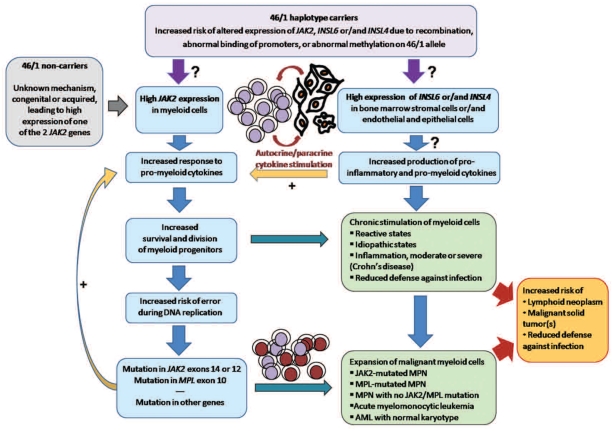Figure 2.
The JAK2 46/1 haplotype as a marker of inappropriate myelomonocytic response to cytokine stimulation, leading to increased risk of inflammation, myeloid neoplasm, and impaired defense against infection. One hypothesis is that the 46/1 haplotype may be linked to high expression of the JAK2 gene and/or of other genes that constitute the haplotype: INSL6 and INSL4. The 46/1 haplotype could lead to high expression of the JAK2 gene on the recombined allele through DNA recombination, mutation, altered promoter accessibility or abnormal methylation. This hypothesis is supported by the fact that high mRNA expression of JAK2 is frequently observed in MPN patients, and required for certain MPN phenotypes in murine models. Thanks to high Jak2 levels, affected myeloid cells would be more likely to divide in response to Jak2-activating cytokines, making genes important for myelopoiesis, such as JAK2 and MPL, at greater risk of copy errors. Acquisition of mutations in JAK2, MPL or other genes would accelerate progression toward myeloid neoplasms. For patients who develop MPN, the presence of the 46/1 haplotype could influence disease evolution and survival. Carriers of the 46/1 haplotype who develop AML with normal karyotype (NK-AML) could have reduced survival due to death from infection, according to Nahajevszky et al. (this issue).10 In addition, the 46/1 haplotype may facilitate expression of INSL6 and INSL4 in non-hematopoietic cells, for instance in bone marrow stromal cells. Possible consequences could be excessive production of cytokines with dual action, pro-myeloid and pro-inflammatory, which would further stimulate expansion of myelomonocytic cells and thus facilitate an inflammatory response and perhaps impair defense against infection. Finally, patients with MPN, AML or severe chronic inflammation have been reported to be at greater risk of lymphoid neoplasms and malignant solid tumors.

